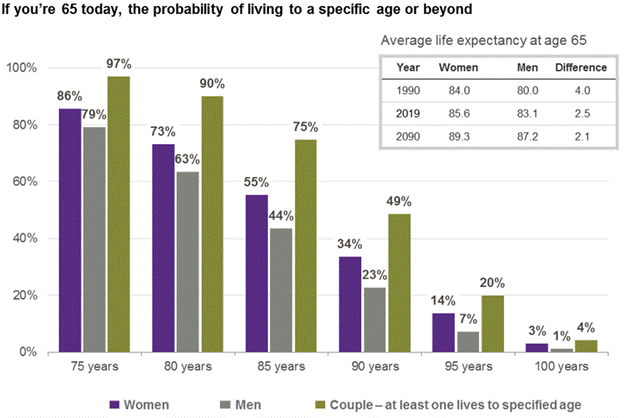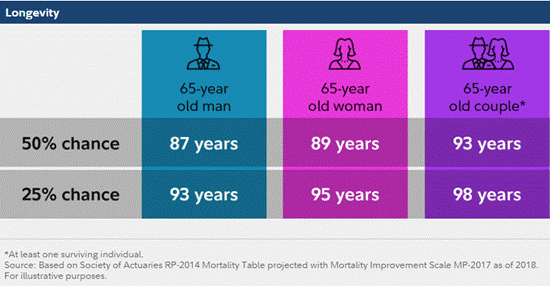Estimating Your Life Expectancy
Apr 21, 2021 • Written by Paul Staib | Certified Financial Planner (CFP®), MBA, RICP®
Blog Home » Retirement Planning » Estimating Your Life Expectancy

A critically important variable in retirement planning is life expectancy. I occasionally joke with retirement planning clients that if they tell me how long they will live, I can advise them more definitively on decisions such as when they can retire, when best to begin Social Security, how much to save and spend, and whether to buy an annuity or LTC insurance to enable their retirement goals! Unfortunately, no one can predict definitively how long someone is going to live. And for most people, estimating their expected lifespan is basically a wild guess, if it is even considered at all. That is a problem because accurately estimating this can be the difference between having a comfortable and enjoyable retirement and not. The risks are significant. Underestimating your longevity can result in running out of money during retirement (longevity risk), resulting in requiring outside assistance from others to pay for your expenses. Conversely, significantly overestimating your longevity can lead to an opposite set of retirement “risks”, including over saving, underspending, and working longer than you need to.
This post provides an overview of estimating your longevity, including tools and considerations to help you plan your retirement, and avoid running out of money in retirement.
Life Expectancy
Life expectancies in the United States continue to increase as more people are living to older ages. The accompanying chart shows the probability that 65-year-old men and women today will reach various ages. For a 65-year-old couple, there is nearly an even 50/50 chance that one of them will live to age 90 or beyond. Individuals should plan for living well beyond the average – to age 95 or even 100 – especially those in good health and with a family history of longevity.
As indicated in the upper right of the graphic, average life expectancy is expected to continue to rise primarily due to heathier lifestyles and medical advancements. You may need to plan on the probability of living much longer – perhaps 30+ years in retirement based on an aged 65 retirement – and invest a portion of your portfolio for growth to maintain your purchasing power over time.

The graphic below depicts similar information using more recent data. While the results are similar, note the increasing life expectancies.

Life Expectancy Estimating Tools
Researchers are beginning to explore ways to use biological markers to estimate more realistic longevity assumptions, but they are likely still a few years out. Until then, there are a growing number of online tools and services aiming to help people obtain personalized lifespan estimates. These range widely in time and information required to obtain an estimate.
At its simplest, the Social Security Administration has an online calculator which will calculate the average number of additional years a person can expect to live, based only on the gender and date of birth you enter.
The more sophisticated calculators require a bit more time (~5-15 minutes) and information relating to lifestyle, nutrition, medical, wealth, and education – all of which academic studies show are highly correlated with life expectancy. Two such calculator tools are Living to 100 and Blue Print Income. Give them a try!
A word of caution when using simple calculator such as the SSA example: the results can vary significantly. My SSA estimate was 13 years less than the estimates calculated using the more personalized tools (for me, the resulting estimates from both non-SSA tools were the same).
While the tools and calculators are getting more sophisticated and likely result in a more accurate estimate than generic ones derived based on actuarial tables alone (like the SSA tool), it is important to remember that these are estimates only.
In simple terms, you should plan to live longer than you think, and adjust your retirement savings plan accordingly. If you believe you might live until age 90, it is beneficial to plan for living to 92 or 93. Especially with retirement planning, it is recommended you err on the side of estimating too long than too short to reduce the risk of outliving your savings.
In Closing…
Estimating how long you are going to live is arguably one of the most important, yet difficult parts of retirement planning. There are so many genetic and lifestyle factors that play into it that it is impossible to estimate with any degree of certainty, which means you will always be guessing at the length of your retirement and how much money you need. And who knows, an unfortunate encounter with the proverbial beer truck can derail the best made plans! However, there are tools you can use to obtain a more accurate estimate for your retirement planning purposes. Having a sense of your estimated life expectancy is important to help you plan both your finances and other important life decisions.

Paul Staib | Certified Financial Planner (CFP®), MBA, RICP®
Paul Staib, Certified Financial Planner (CFP®), RICP®, is an independent Flat Fee-Only financial planner. Staib Financial Planning, LLC provides comprehensive financial planning, retirement planning, and investment management services to help clients in all financial situations achieve their personal financial goals. Staib Financial Planning, LLC serves clients as a fiduciary and never earns a commission of any kind. Our offices are located in the south Denver metro area, enabling us to conveniently serve clients in Highlands Ranch, Littleton, Lone Tree, Aurora, Parker, Denver Tech Center, Centennial, Castle Pines and surrounding communities. We also offer our services virtually.
Read Next
Financial Ratios: A Quick Way to Check and Monitor Your Personal Financial Health
• Written By Paul Staib | Certified Financial Planner (CFP®), MBA, RICP®
“Prevention is better than cure”. You need to assess your fiscal health and take corrective action before it’s too late….
The Ins and Outs of Social Security Benefits and Taxes
• Written By Paul Staib | Certified Financial Planner (CFP®), MBA, RICP®
It’s an unpleasant fact of life: The taxman can take a bite out of your Social Security benefits. The…
